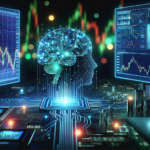The Role of AI in Automated Trading Strategies
Understanding Automated Trading
Automated trading, often referred to as algorithmic trading, involves using computer programs to trade financial instruments on behalf of traders. These systems analyze market data, identify trading opportunities, and execute trades all at lightning speed, far surpassing human capabilities. This process is increasingly enhanced by artificial intelligence (AI), which can adapt to changing market conditions more efficiently than traditional algorithms.
How AI Enhances Automated Trading
Data Analysis and Pattern Recognition
One of the most significant advantages of AI in automated trading is its ability to analyze vast amounts of data. Traditional models might rely on historical prices and volume data, but AI can incorporate alternative data sources, such as social media sentiment, news articles, and even satellite imagery. By employing machine learning techniques, AI systems can identify complex patterns that humans may overlook.
For instance, by analyzing tweets and news articles about a particular stock, an AI algorithm can gauge public sentiment and predict price movements based on social media chatter. This leads to more informed trading decisions and potentially higher profits.
Adaptive Learning
AI systems, especially those that use reinforcement learning, have the capability to adapt their trading strategies in real-time. Unlike conventional algorithms, which might operate on a fixed set of rules, AI models can learn from their experiences. If a trading strategy proves successful under specific market conditions, the model can refine and optimize that strategy. Conversely, if it experiences a loss, it can analyze what went wrong and adjust to prevent similar mistakes in the future.
Risk Management
Another critical area where AI shines is in risk management. Automated trading strategies come with inherent risks, but AI can help mitigate these by constantly monitoring market conditions and adjusting parameters accordingly. AI can also analyze historical drawdowns, volatility, and market behavior to set appropriate stop-loss orders, thus protecting capital more effectively than manual trading.
Current Trends in AI-Driven Trading Strategies
Natural Language Processing (NLP)
NLP is a branch of AI that focuses on the interaction between computers and human language. In the context of trading, NLP can analyze news articles, earnings reports, and even conference calls to extract relevant information. This capability allows traders to stay ahead of the curve by processing qualitative data that could influence price movements.
For example, by using NLP algorithms to dissect quarterly earnings calls, traders can gather insights into a company’s performance and management outlook, translating this qualitative data into quantifiable trading signals.
Algorithmic Trading Competitions
AI-driven trading competitions have been gaining popularity, providing a platform for developers and traders to showcase their strategies. These competitions often involve creating a trading bot that competes against others in simulated trading environments. Such events stimulate innovation and lead to the discovery of new, effective trading strategies, often pushing the boundaries of what AI can achieve in finance.
The Integration of AI with Other Technologies
Blockchain and AI
The combination of blockchain technology and AI presents exciting opportunities for automated trading. Blockchain enhances transparency and security, which can improve trust in algorithmic trading operations. Furthermore, leveraging AI can enhance the efficiency of blockchain transactions, providing real-time insights and market predictions.
For instance, smart contracts powered by AI could automatically execute trades when certain market conditions are met, combining the benefits of automation, security, and adaptability.
Cloud Computing and Big Data
As the market continues to generate enormous amounts of data, cloud computing offers scalable solutions for AI models. The cloud allows traders to access powerful computational resources without the need for expensive hardware infrastructure. This makes it feasible for individual traders and small firms to leverage AI, democratizing access to advanced trading tools.
Moreover, big data analytics combined with AI can help traders collect and interpret massive datasets, improving trading strategy development and execution.
Challenges and Considerations for AI in Automated Trading
Market Volatility and Black Swan Events
While AI can enhance trading strategies, it is not immune to the unpredictability of financial markets. Sudden market movements or black swan events can lead to unexpected losses, even for the most sophisticated AI models. Traders must remain vigilant and consider incorporating human oversight into their trading strategies to navigate these unpredictable periods.
Ethical and Regulatory Concerns
The rise of AI in automated trading also raises ethical and regulatory questions. High-frequency trading strategies can exacerbate market volatility and create an uneven playing field. Regulators are closely monitoring the use of AI in trading to ensure fair market practices. Striking a balance between innovation and ethical consideration is crucial for the future of AI in trading.
The Future Landscape of AI in Trading
Personalized Trading Strategies
As AI continues to evolve, we can expect the development of personalized trading strategies tailored to individual investor preferences. By analyzing an investor’s risk tolerance, financial goals, and trading behavior, AI can create customized trading plans. This shift may lead to a more democratized trading experience, empowering individual investors with sophisticated tools that were previously accessible only to institutional players.
Emphasis on Transparency
In the coming years, there is likely to be a growing emphasis on transparency in AI-driven trading strategies. Traders and investors will demand more insight into how AI systems develop their strategies and make decisions. Ensuring that these systems are explainable and accountable will not only enhance trust but also foster broader adoption of AI in finance.
Collaboration Between Humans and AI
Rather than viewing AI as a replacement for human traders, the future will likely see a collaborative approach where humans and AI work together. Human intuition can complement AI’s analytical capabilities, leading to more robust trading strategies. By combining the strengths of both, traders can make more informed decisions and navigate the complexities of the financial markets.
In summary, the future of AI in automated trading strategies appears promising. With ongoing advancements in technology, data analysis, and machine learning, traders are well-equipped to leverage AI’s capabilities to enhance trading outcomes. Embracing these changes while addressing the associated challenges will be key to thriving in the evolving landscape of finance.








